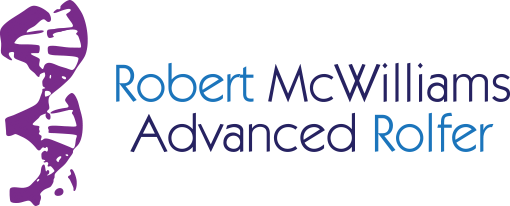In Rolf Movement work, we look to re-activate areas that can help us that have been sluggish. A key spot is the base of the scapula..aka shoulder blades..also aka chicken wings..never mind! Anyway, a lot of the reason we get shoulder and neck pain is overuse of the muscles on the top of the shoulder. The usual suspects: upper trapezius, levator scapula, supraspinatus. Folks, this can be relieved through myofascial work, then prevented by improved coordination. We want to wake up that bottom corner of the shoulder blade, called the inferior angle, and the muscles that move it, mainly the lower trapezius and rhomboids. The Shoulder Pulse exercise, taught to me by Mary Bond, a very well-know Rolf Movement master, helps start that process.
Start by finding the inferior angle of your scapula. Laying on your back, slide one arm across your body, and reach below it with the opposite arm and across the ribs a bit until you find the shoulder blade. Move down the outer edge of the bone until you find its lower tip. Gently rotate your shoulders little, and use your fingers to open and awaken the tissues all around the pointy bottom surface of the bone. This should help you get a better feel for where it is, in your body image. Relax your position, so that you are lying flat on your back again. Now is the hard part: Isolate that place, in a short downwards pulsing movement. Just pulse down and release-do not hold a position. Do not push the shoulder forwards. Do not tense your back muscles, or arm muscles. Just pulse the bottom tip of the shoulder blade down towards you feet.
When you start to feel like you have “found it”, try initiating an arm reach with a shoulder pulse, first. Do not hold the muscle contraction. It is a muscle coordination exercise, and timing is important.Just use the shoulder pulse to start an arm reach, then drop the arm and relax it. Do this several times, to feel the coordination. Now try the shoulder pulses sitting up. It may be more challenging for you to find the inferior angle and isolate it in movement, while seated. It helps to keep trying, and even to go back to laying down to reacquaint yourself with it, then try again. Do the same standing. Do it while waiting in line. Do it in the morning when you are first waking up. Fun!
Over time, you want to explore how to use this to initiate most all movements of the arms. This can help your arm movements flow more freely and beautifully! When you do the opposite, and initiate from the top of the shoulder, the effect is neck pain, stooped posture and fatigue. You can also use this technique to counter those symptoms, when you feel them coming on.Try it!!
